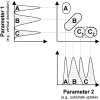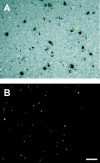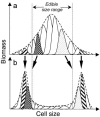Fate of heterotrophic microbes in pelagic habitats: focus on populations
- PMID: 16148306
- PMCID: PMC1197807
- DOI: 10.1128/MMBR.69.3.440-461.2005
Fate of heterotrophic microbes in pelagic habitats: focus on populations
Abstract
Major biogeochemical processes in the water columns of lakes and oceans are related to the activities of heterotrophic microbes, e.g., the mineralization of organic carbon from photosynthesis and allochthonous influx or its transport to the higher trophic levels. During the last 15 years, cultivation-independent molecular techniques have substantially contributed to our understanding of the diversity of the microbial communities in different aquatic systems. In parallel, the complexity of aquatic habitats at a microscale has inspired research on the ecophysiological properties of uncultured microorganisms that thrive in a continuum of dissolved to particulate organic matter. One possibility to link these two aspects is to adopt a"Gleasonian" perspective, i.e., to study aquatic microbial assemblages in situ at the population level rather than looking at microbial community structure, diversity, or function as a whole. This review compiles current knowledge about the role and fate of different populations of heterotrophic picoplankton in marine and inland waters. Specifically, we focus on a growing suite of techniques that link the analysis of bacterial identity with growth, morphology, and various physiological activities at the level of single cells. An overview is given of the potential and limitations of methodological approaches, and factors that might control the population sizes of different microbes in pelagic habitats are discussed.
Figures








Similar articles
-
Metagenomic and Metaproteomic Insights into Photoautotrophic and Heterotrophic Interactions in a Synechococcus Culture.mBio. 2020 Feb 18;11(1):e03261-19. doi: 10.1128/mBio.03261-19. mBio. 2020. PMID: 32071270 Free PMC article.
-
Distinctive Patterns in the Taxonomical Resolution of Bacterioplankton in the Sediment and Pore Waters of Contrasted Freshwater Lakes.Microb Ecol. 2018 Apr;75(3):662-673. doi: 10.1007/s00248-017-1074-z. Epub 2017 Sep 17. Microb Ecol. 2018. PMID: 28920165
-
Bacterial carbon processing by generalist species in the coastal ocean.Nature. 2008 Feb 7;451(7179):708-11. doi: 10.1038/nature06513. Epub 2008 Jan 27. Nature. 2008. PMID: 18223640
-
Competition and niche separation of pelagic bacteria in freshwater habitats.Environ Microbiol. 2017 Jun;19(6):2133-2150. doi: 10.1111/1462-2920.13742. Epub 2017 May 10. Environ Microbiol. 2017. PMID: 28370850 Review.
-
Marine Bacterioplankton Seasonal Succession Dynamics.Trends Microbiol. 2017 Jun;25(6):494-505. doi: 10.1016/j.tim.2016.12.013. Epub 2017 Jan 17. Trends Microbiol. 2017. PMID: 28108182 Review.
Cited by
-
Small changes in pH have direct effects on marine bacterial community composition: a microcosm approach.PLoS One. 2012;7(10):e47035. doi: 10.1371/journal.pone.0047035. Epub 2012 Oct 11. PLoS One. 2012. PMID: 23071704 Free PMC article.
-
Container volume may affect growth rates of ciliates and clearance rates of their microcrustacean predators in microcosm experiments.J Plankton Res. 2021 Mar 17;43(2):288-299. doi: 10.1093/plankt/fbab017. eCollection 2021 Mar-Apr. J Plankton Res. 2021. PMID: 33814976 Free PMC article.
-
Spatial and temporal patterns in the microbial diversity of a meromictic soda lake in Washington State.Appl Environ Microbiol. 2008 Aug;74(15):4877-88. doi: 10.1128/AEM.00455-08. Epub 2008 Jun 13. Appl Environ Microbiol. 2008. PMID: 18552187 Free PMC article.
-
Community and single cell analyses reveal complex predatory interactions between bacteria in high diversity systems.Nat Commun. 2021 Sep 16;12(1):5481. doi: 10.1038/s41467-021-25824-9. Nat Commun. 2021. PMID: 34531395 Free PMC article.
-
Patterns and mechanisms of genetic and phenotypic differentiation in marine microbes.Philos Trans R Soc Lond B Biol Sci. 2006 Nov 29;361(1475):2009-21. doi: 10.1098/rstb.2006.1928. Philos Trans R Soc Lond B Biol Sci. 2006. PMID: 17062417 Free PMC article. Review.
References
-
- Acinas, S. G., V. Klepac-Ceraj, D. E. Hunt, C. Pharino, I. Ceraj, D. L. Distel, and M. F. Polz. 2004. Fine-scale phylogenetic architecture of a complex bacterial community. Nature 430:551-554. - PubMed
-
- Alldredge, A., and M. Silver. 1988. Characteristics, dynamics and significance of marine snow. Prog. Oceanogr. 20:41-82.
Publication types
MeSH terms
Substances
LinkOut - more resources
Full Text Sources

